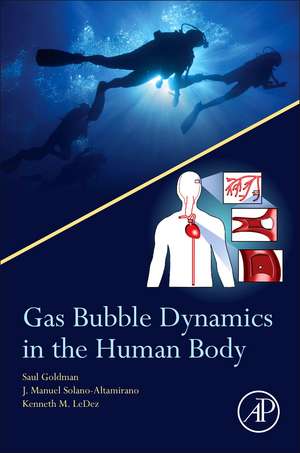Gas Bubble Dynamics in the Human Body
Autor Saul Goldman, Manuel Solano-Altamirano, Kenneth Ledezen Limba Engleză Paperback – 17 sep 2017
- Demonstrates how physical and mathematical tools help to solve underlying problems across physiology and medicine
- Helps researchers extend their competence and flexibility to the point that they can personally contribute to the field of hyperbaric medicine and physiology, or to other related biological problems that may interest them
- Provides clinicians with explicit examples of how mathematical modelling can be integrated into clinical treatment and decision-making
Preț: 686.77 lei
Preț vechi: 899.77 lei
-24% Nou
Puncte Express: 1030
Preț estimativ în valută:
131.43€ • 136.71$ • 108.50£
131.43€ • 136.71$ • 108.50£
Carte tipărită la comandă
Livrare economică 07-21 aprilie
Preluare comenzi: 021 569.72.76
Specificații
ISBN-13: 9780128105191
ISBN-10: 0128105194
Pagini: 320
Dimensiuni: 152 x 229 x 18 mm
Editura: ELSEVIER SCIENCE
ISBN-10: 0128105194
Pagini: 320
Dimensiuni: 152 x 229 x 18 mm
Editura: ELSEVIER SCIENCE
Public țintă
This book is intended for people who are interested in or concerned about gas-bubble disease (decompression sickness and gas embolism) in humans. This covers a broad range of potential readers, from those with an academic interest in the math, physics and chemistry aspects, to those involved in treating or causing gas bubbles in the body. This includes researchers, students and graduates, and those with a PhD in biochemistry, biophysics, molecular biology, computational chemistry, physiology, and applied mathematics. It also applies to physicians and healthcare professionals, including hyperbaric and diving medicine, anesthesiology and many other medical and surgical fields that can cause entry of gas bubbles into patients. It will also be of interest to experts in professional diving. The analyses in the book range from clinical to mathematical. Material from each end of spectrum will enable those at the other end to appreciate the complexity of the entire spectrum. While there may be more math or more clinical content than purists from one side or another might prefer, understanding gas-bubble disease requires an interdisciplinary approach, and there is ample specialized content in the book to interest the full spectrum of those interested in gas-bubble disease.Cuprins
1. Bubbles in the body: The not so good, the bad and the ugly2. Driving force for gas bubble growth and dissolution3. Rates of gas bubble growth and dissolution in simple liquids4. Estimating the radii and lifetimes of small gas bubbles suspended in simple liquids5. AGEs in scuba diving and in DCS-like problems in breath-hold diving6. Gas bubbles in soft tissue-like solids7. The evils that bubbles do8. Compartmental decompression models and DCS risk estimation9. Treating teh evils that bubbles do10. Merging medicine and Mmath: Gas bubble dynamics in the treatment of gas-bubble disease
